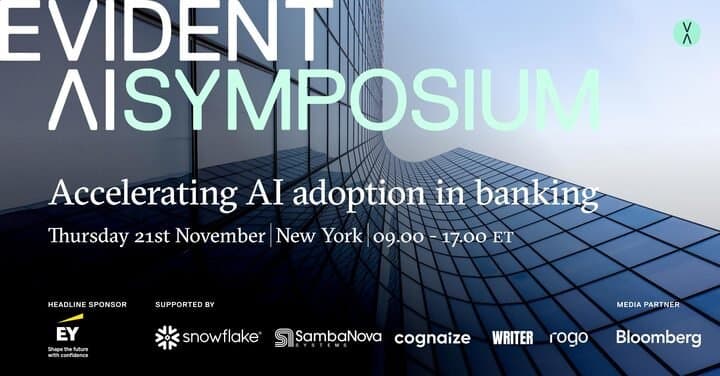
DATA-DRIVEN INSIGHTS AND NEWS
ON HOW BANKS ARE ADOPTING AI
Find me the AI money

Source: Image generated by Adobe Firefly
19 September 2024
TODAYS BRIEF
Welcome back to The Brief!
Today, as investors are increasingly looking for more info about AI's return on investment, we explore which banks are opening up about their ROI using fresh data from the 2024 Evident AI Index – coming out on October 17. Also in this newsletter: highlights from Evident's AI Leadership Roundtable, a dispatch from the RAI Summit in London, and more AI applications in our Use Case Corner.
Looking ahead, please save the date: The Evident AI Symposium is coming up in NYC on November 21st. Scroll down for more info and register today.
The Brief is 1,912 words, a 6 minute read. If this newsletter was forwarded to you, subscribe here. We want to hear from you: [email protected].
– Alexandra Mousavizadeh & Annabel Ayles
LATEST FROM THE EVIDENT AI INDEX
MIND THAT $600B GAP
“The AI bubble is reaching a tipping point,” says David Chan at Sequoia Capital. To expand on that mixed metaphor, the bubble may be about to hit the fan! The gap between what’s being spent to build out AI (mostly by tech companies) and the actual revenue realized by that investment is $600 billion this year, up from $200 billion in September 2023, according to Chan. Markets are asking Big Tech hard questions about when and where we’ll see tangible returns on investment. The world’s leading banks are getting them too.
Surely answers are coming, no? We’re crunching the latest data ahead of the October 17th update of the Evident AI Index and well, not really. While 38 of the 50 banks we track announced at least one use case in the last year, only 21 reported any outcomes associated with those use cases. And of those, only two – JPMorgan Chase and DBS – went so far as to specify their total actual realized $ return on AI spend last year.
JPMC: “...roughly the value that we assign to our artificial intelligence use cases is around between $1 billion to $1.5 billion and is in the fields of customer personalization, trading, operational efficiencies, fraud manager, credit decisioning.” (see Page 4 of 2024 Investor Day)
DBS: “Our use of AI/ML became more broad-based in 2023, and we delivered an economic value of SGD 370 million, more than double that in 2022.” (see Page 10 of 2023 Annual Report)
Nothing to Report Here
What banks revealed about the return on their investments in AI use cases, based on investor relations materials (n=50 banks tracked by Evident AI Index)

Our annual ranking of how banks are adopting AI will provide more insights. Look for the updated Evident AI Index 2024 on October 17.
EVIDENT ROUNDTABLE
AI LEADERSHIP PRO TIPS
Speaking of speaking clearly about what you’re doing on AI… the experts we brought together on Tuesday for the Evident AI Leadership Roundtable emphasized that better communications about AI is a hallmark of leadership and maturity.
James Utting (Chief Business Officer, Group Emerging Technology at UBS) and Ken Usdin, (Managing Director, Equity Research at Jefferies LLC) discussed that and other conclusions from our new Leadership Report. Below are their three AI leadership hacks. Check out the full recording here.
Show them the money
You have to move from surface-level mentions of AI in your comms and demonstrate real value. Investors, customers, and analysts are demanding to see real-world applications of AI, not just press releases. “As an analyst, the thing that I think about next is results,” Ken Usdin said. “If you’re going to be a leader communicating the strategy and putting it forward, then it’s one thing to have estimates of business impact, but we like to look at proof points.”
Get your narrative straight
Take the time to build your organizational consensus around AI, James Utting said, because it’s imperative that you’re consistent in how you talk about AI – whether in investor relations, press releases, or social media. You need transparency and consistency to build credibility with customers, regulators, and investors.
AI everywhere
You don’t have just an AI strategy anymore. Your AI strategy is your business strategy – it’s everywhere, across all departments, no longer the province only of specialist teams and increasingly owned by leaders across the company. “The task is no longer to find the niche cases scattered around organizations,” Utting said. “The task is now thinking about how you integrate AI across your organization. You need a clear and unified strategy, and you need to be willing to educate each of your stakeholders on that journey. And that is something that any bank of any size can do.”
SAVE THE DATE
NEW YORK, NEW YORK

The Evident AI Symposium is taking place in New York City on November 21.
The exclusive, invitation-only event gathers the 200 most senior leaders across the banking and AI industries to drive the global conversation on the realities of AI adoption.
We’ll unpack the key findings from the latest Evident AI Index ranking and take stock of where banks are in their AI journeys. Which banks are leading the way? Where are they delivering value? And what are the headwinds and opportunities on the horizon?
Click below to learn more and register your interest to attend (in person or virtually).
NOTABLY QUOTABLE
"“We find that when AI-powered experiences drive demonstrably better outcomes for customers, this builds trust, confidence, and ultimately engagement – and the more our customers engage with us, the better we can anticipate their needs.”"
— Andrew McMullan, CDAO of CommBank, on their new AI Factory, September 17
REPORTING LIVE
THREE RAI TAKEAWAYS
Research Analyst Sam Meeson attended the 2nd annual Responsible AI Summit, a gathering of the best industry minds on the topic, in London this week. Here are the key takeaways:
#1 More AI, more risk
As banks increase adoption of Gen AI, there’s a lot more to do on RAI, said Anna Hannem, VP for data & AI risk at Scotiabank. But resources aren’t always keeping pace with the increasing volume and complexity of the work.
Consider this telling exchange that Luke Vilain, AI governance lead at UBS, had with the audience.
Vilain: How many people here are working on AI governance?(Most of the room raised hands)
Vilain: How many people here feel they are well funded?(Almost no one raised a hand)
#2 Hey, big energy guzzler
The heavy use of energy to power LLMs is a growing personal concern for Paul Dongha, head of Responsible AI & AI Strategy at NatWest, because of the commercial and environmental cost that this entails. His presentation on sustainability advocated for cloud providers to disclose how much energy is used when a user writes a Gen AI prompt, which struck a chord in the room among people who thought they had an ethical duty to reduce the carbon footprint of the technology.
#3 RAI strategy = AI strategy
AI governance is a fundamental part of the AI strategy, said Oliver Patel, enterprise AI governance lead at AstraZeneca, and not a separate workstream. But be mindful of getting bogged down in being responsible, cautioned Patel: “The risk of not adopting AI is potentially bigger than the risk of adopting it.”
MEET THE MODEL
STRAWBERRY SEASON
This week, we’re looking at OpenAI’s new “thinking model” paradigm, as well as some business-friendly announcements from top model providers.
The Model: OpenAI’s o1 models (codename: Strawberry)
What is it? A family of new models, including o1-mini (a smaller model great for code generation)
What does it do?
- Slow on purpose: Designed for answering more complex questions, o1 pauses to “think” before providing an answer.
- Multi-step reasoning: o1 breaks large problems into multiple smaller ones and is the first model vendor out the gate with this functionality (though others will likely be close behind).
- Burns a hole in your pocket: o1 costs between 4-17 times what GPT-4o costs to run because you’re paying for the time the model “thinks”.
Other models in the news:
- Anthropic launched their enterprise version of Claude, adding GitHub integration, more security, and admin controls. The announcement comes one year after OpenAI’s ChatGPT Enterprise release.
- Cohere partners with Nomura Research Institute in Japan to launch a new financial AI platform. “By integrating Cohere’s Command R+ and Embed models through Oracle Cloud Infrastructure (OCI) Generative AI services, the platform will support key financial operations such as sales, compliance, and back-office tasks.”
- Mistral announced across-the-board price cuts, an improved small model, and a new vision-LLM on their API that can take both images and text as an input.
USE CASE CORNER
PICK AN LLM… ANY LLM
In this week’s Use Case Corner, we look at four of the most interesting tools unveiled in the past couple of weeks.
And ICYMI: Check out our special edition Brief on 74 AI use cases.
#1 M&A Analysis AI Tool
Use Case: M&A “Co-Pilot”
Vendor: n/a
Bank: UBS
Why it’s interesting: UBS’s M&A division has used this custom-built AI tool for the past year to identify potential deals. By analyzing all 300,000 companies in its database in “less than half a minute”, the tool saves time – identifying takeover targets can normally take two to four weeks – and provides new, fresh M&A ideas.
Potential ROI → increased efficiency, increased customer satisfactionReported ROI → n/a
#2 Pick Your Own LLM
Use Case: LLM SuiteVendor: MultipleBank: JPMorgan Chase
Why it’s interesting: As part of its efforts to democratize AI, JPMC gives 140,000 employees access to external LLMs through the LLM Suite to help with everyday tasks (writing emails, generating reports, summarizing documents). While initially launched with access to OpenAI’s LLM, the Suite will give employees the ability to move “fluidly” across models.
Potential ROI → increased efficiency, increased employee productivity, increased employee satisfactionReported ROI → n/a
#3 Homegrown AI Financial Manager
Use Case: Maxiaocai
Vendor: n/a
Bank: Ant Group
Why it’s interesting: China’s Ant Group developed its own foundation model – BaiLing – and used it to build a customer-facing financial management tool with 70 million monthly active users. Other Chinese financial institutions, including asset management companies and securities firms, use the platform.
Potential ROI → increased customer satisfaction, increased potential revenue
Reported ROI → n/a
#4 AI-enabled Money Order Processing
Use Case: Commonfax
Vendor: Instabase
Bank: İşbank
Why it’s interesting: Turkish İşbank’s subsidiary Maxitech built a document extraction tool in partnership with Instabase for processing customer money orders. Initial reported efficiency outcomes have been positive, as the tool reduces the manual classification and data entry work required from employees. The tool marks the first time a bank has launched a “cutting-edge AI solution” in Turkey, according to Meltem Vural, head of Enterprise Architecture at İşbank.
Potential ROI → increased efficiency, increased accuracyReported ROI → increased successful classification ratio from 41% to 85%; increased successful extraction ratio from 23% to 75%
Have feedback on or ideas about use cases? Let us know at [email protected].
EVIDENT SPEED READS
5 STORIES THAT CAUGHT OUR ATTENTION
JPMC’s Daniel Pinto raised the bar from $1.5 billion to $2 billion in expected value from AI, driven by a range of use cases and incremental efficiency gains across the business, especially AI in fraud detection. JPMC also filed a patent for “algorithmic bias evaluation of risk assessment models,” allowing it to track when algorithms make questionable decisions.
DBS had twice as many technologists as bankers in 2023, according to a Harvard Business School case-study on the bank. It employed “2,500 data scientists, analysts, and engineers – double the number of traditional bankers.”
CommBank partnered with AWS to launch an in-house “AI Factory” to advance AI and Gen AI initiatives at the bank. They also partnered with the University of Adelaide to establish the CommBank Centre for Foundational AI to foster ML research for applications in finance and other sectors.
More AI regulations across the globe: The Qatar Central Bank (QCB) issued new rules for financial institutions, and the Hong Kong Monetary Authority (HKMA) issued new guidelines for banks using Gen AI.
Partnering with OpenAI has been “revolutionary” for BBVA, said Head of AI Adoption Elena Alfaro. Bank employees from various business areas “can create their own boards and prototype complex applications.” Previously this would require “specific resources and technical expertise,” but now these capabilities are accessible to those closer to the problems being solved.
TALENT MATTERS
INDIA IN THE DRIVER’S SEAT
NatWest hired Ruchika Panesar as country head of NatWest in India. Panesar, previously global head of enterprise communications and marketing technology at American Express, will be in charge of a pivotal piece of NatWest’s transformation: 50% of the India workforce reportedly works in technology or analytics, driving around 50% of the global tech operations of the company.
Westpac named Anthony Miller, head of its business and wealth unit, as their new CEO. The current CEO Peter King is retiring, passing the baton this December. King was an active voice on AI use cases at Westpac, noting its anti-fraud capabilities will be tailored on a customer-by-customer basis.
Standard Chartered appointed Alvarro Garrido as Group CIO. Garrido was previously group chief information security officer at the company.
Have a job opening you want to list here? Send it our way: [email protected]
COMING UP
Tue 24 Sep
Future of AI in Financial Services Conference, London
Tue 24 Sep - Thu 26 Sep
Central Bank AI Conference, London
Wed 25 Sep
Moody’s: Demystifying GenAI for Credit Risk, Madrid
Mon 30 Sep
FINOS Conference, New York
Tue 1 Oct
AI & Big Data Expo, Amsterdam
Wed 2 Oct - Thu 3 Oct
Reuters: MOMENTUM AI, London
Thu 21 Nov
Evident AI Symposium, New York
THE BRIEF TEAM
- Alexandra Mousavizadeh|Co-founder & CEO|[email protected]
- Annabel Ayles|Co-founder & co-CEO|[email protected]
- Colin Gilbert|VP, Intelligence|[email protected]
- Andrew Haynes|VP, Innovation|[email protected]
- Alex Inch|Data Scientist|[email protected]
- Matthew Kaminski|Senior Advisor|[email protected]
- Sam Meeson|AI Research Analyst|[email protected]
- Mike Silverman|Director of Research|[email protected]